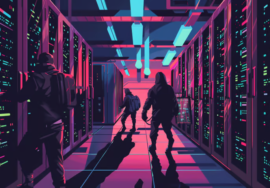
Flexential CEO warns network could be cloud’s next coveted resource

- Network connectivity is a critical resource both within and between data centers
- Flexential’s CEO has his eye on what increased demand for network inside data centers means for transport
- Dark fiber could become a cloud bottleneck
Land and power are two massively critical resources for data centers, but there’s a third resource that Flexential CEO Chris Downie said he is watching closely: networks.
Flexential has been playing in the data center space for more than 20 years (taking on its current moniker in 2018) and currently operates 42 data center facilities in 19 U.S. markets.
Downie noted these locations were historically viewed as “secondary” markets, outside the big hubs of Northern Virginia, Santa Clara and Dallas. Think Denver, Las Vegas, Salt Lake City, Charlotte, Raleigh, Richmond, Tampa, Philadelphia and Cincinnati. Now, though, these areas are increasingly popular due to the relatively ready availability of land and power.
In addition to compute, the company provides transport connectivity between data centers with networks leased from the likes of Lumen, Zayo and Crown Castle on a regional basis. But as the rise of artificial intelligence (AI) and GPUs drives demand for more networking power within data centers, Downie said he’s thinking about the impact that will have on network demand between data centers.
“What has happened over the last 18 months is this AI GPU demand has made the data center resource very scarce. But ultimately what I’m thinking about next is network,” he said. “So, the amount of networking that’s going on inside the facility, what are the implications of that for the networking outside the facility? We’ve been providing inter-facility national transport for a while now, but is that resource going to become prioritized to the point of scarcity?”
He continued: “Ultimately, there’s only so much fiber in a market that feeds data centers. And so if network consumption is prioritized like data center consumption has been over the course of the last 18 months, theoretically, the network provider should have stronger pricing power…if more people want it they’re going to pay more for it.”
Downie isn’t the only one attuned to this trend. Late last year, Zayo’s Chief Product Office Bill Long told Fierce Network it was investing heavily in its 400-gig fiber backbone network to meet rising demand for long-haul connectivity driven by AI. At the time, he noted the fiber counts requested by customers had jumped by 5X or more.
In March, dark fiber provider Light Source Communications also talked up its plan to build a 140-mile fiber ring in and around Phoenix specifically to serve the growing number of data centers there. Meanwhile, Uniti announced it will build 70 route miles of new fiber to serve a hyperscale cloud customer in Alabama.
Dell’Oro Group VP Jimmy Yu told Fierce that data center operators looking to skirt power bottlenecks may try to spread out their GPU compute clusters into different data centers and connect them with high-speed optical networks. If there’s already fiber connecting these locations, they can add additional wavelengths or upgrade to faster speeds to meet AI demand.
Asked what would happen if there’s simply not enough dark fiber available, Yu said, “That would become a problem and a new bottleneck for the cloud service providers.”
“Most likely, the cloud service provider will need to build additional data centers at sites that have fiber available, ask a fiber provider to build more fiber routes for them, or build new fiber routes themselves,” he added.









